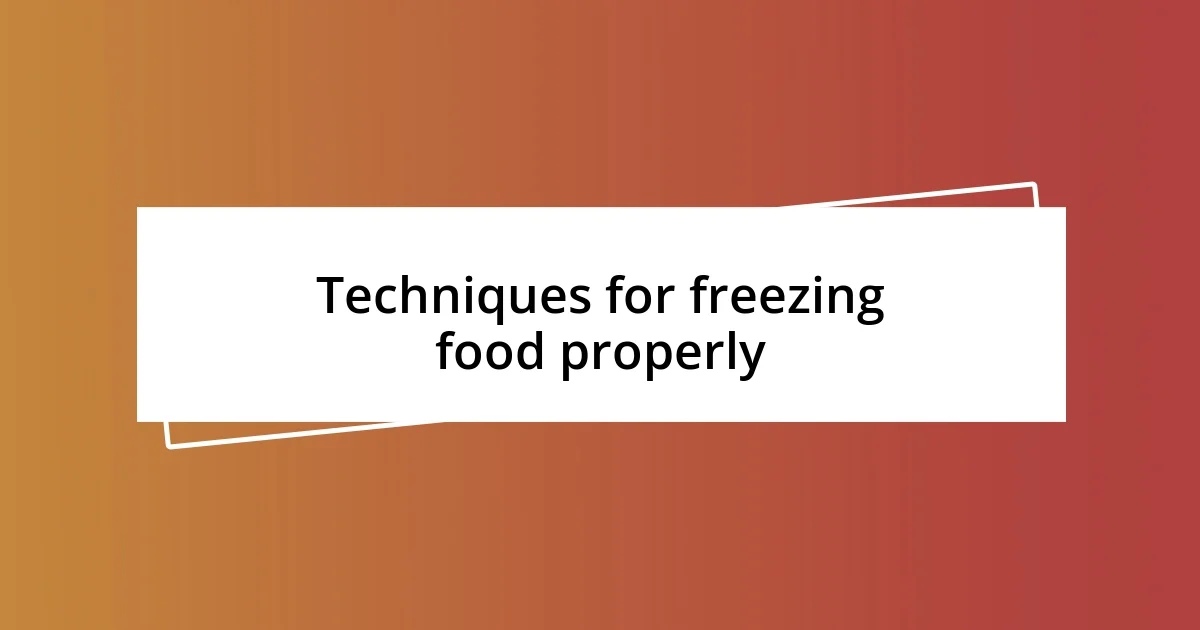Key takeaways:
- Understanding various food preservation methods, such as canning, freezing, and fermenting, helps reduce waste and extend food lifespan.
- Choosing the right preservation technique depends on factors like food type, storage space, flavor preferences, and time investment.
- Essential tools like canning sets, vacuum sealers, and dehydrators enhance the effectiveness and enjoyment of food preservation practices.

Understanding food preservation methods
When I first started exploring food preservation methods, I was amazed to discover how diverse they could be. From canning to freezing, each technique serves a unique purpose and can significantly extend the life of your food. Have you ever thought about how much you waste when you toss out spoiled produce? It really hit home for me when I realized that something as simple as pickling cucumbers could prevent waste and transform them into a delicious condiment.
I remember the overwhelming joy of my first successful batch of homemade jams. The bursting flavors and the vibrant colors were exhilarating, reminding me that preserving food isn’t just about saving money; it’s about savoring summer’s bounty all year round. The sense of connection to the seasons is palpable when you know you’ve captured a moment in time through these methods—how many of you have tasted the warmth of summer preserved in a jar during winter’s chill?
Understanding these methods means recognizing their science too—like how high salt concentrations inhibit bacterial growth in curing or how heat destroys harmful microorganisms in canning. Isn’t it fascinating that these ancient techniques continue to protect our food today? Embracing this knowledge empowered me to experiment in my kitchen, making food preservation not just a necessity but an enjoyable craft.

Choosing the right preservation technique
Choosing the right preservation technique can feel daunting, especially with so many options available. I’ve often tripped over decisions—should I can, freeze, or dry? Each method has its own charm, and I’ve found that choosing the right one truly depends on the food type and my personal taste preferences. For example, I love making homemade tomato sauce during peak season and canning it for cozy winter meals. It’s a simple act that brings warmth to my heart every time I twist open a jar.
When determining the best preservation method, consider these factors:
– Food type: Some foods freeze better, while others maintain their flavor best when canned.
– Storage space: Canning requires more upfront equipment and space, whereas freezing simply needs a deep freeze.
– Flavor and texture: Dried fruits have a distinct taste and chewiness that I adore—something that freezing can’t replicate.
– Time investment: Some techniques, like fermenting, can take weeks, while quick freezing is immediate.
Ultimately, it’s about what resonates with me and my lifestyle. Each technique has its learning curve, but those moments of triumph—like my first batch of fermented pickles—make the journey worthwhile.

Essential tools for food preservation
Essential tools play a pivotal role in food preservation, making my process not only effective but also enjoyable. One essential tool I rely on is a canning set, which includes a water bath canner, jars, and lids. The joy I felt the first time I used it was indescribable—I felt like a kitchen magician as I transformed fresh produce into beautiful, sealed jars ready to be savored later. The satisfaction of hearing the familiar ‘pop’ of a jar sealing is a sound that echoes in my memory as a symbol of successful preservation.
Another tool that has become indispensable in my kitchen is a vacuum sealer. Initially, I was skeptical about investing in it, but now I can’t imagine food preservation without it. The moment I sealed my first batch of marinated vegetables, I realized how much flavor it locks in. Not only does it help prevent freezer burn, but it also results in vibrantly flavored meals ready in minutes. Have you ever tasted something you prepared months ago and found it still bursting with flavor? It’s truly a game changer!
Lastly, let’s not forget the importance of a reliable food dehydrator. I still remember the aromatic wafts of herbs I dried last summer; each herb captured summer’s essence, creating a delightful sensory experience. Drying spices not only saves money but allows me to keep that vibrant garden scent throughout the year. These tools blend practicality with creativity, making food preservation an exciting adventure.
| Tool | Function |
|---|---|
| Canning Set | Used for jar sealing to extend shelf life of foods |
| Vacuum Sealer | Removes air to prevent freezer burn and keep food fresh |
| Food Dehydrator | Removes moisture to extend shelf life and amplify flavors |

Best practices for canning food
Canning is an art that requires attention to detail, and I’ve learned a few best practices along the way. For starters, I always ensure my jars and lids are sterilized before I begin. There’s something soothing about the ritual of boiling them; it makes me feel like I’m nurturing my food right from the start. Do you remember how satisfying it feels to see everything gleaming? That’s the first step to success in my book.
Next, using the right acidity levels is crucial. I’ve had my fair share of mishaps when I overlooked this detail. For instance, when attempting to can peaches, the syrup should be sweet and not overpowering, but also acidic enough to safely preserve them. I often remind myself that even a small miscalculation can alter the final taste or, worse, compromise food safety. I always double-check my recipes and follow safe canning guidelines—they’re my safety net!
Finally, timing is everything. I’ve learned to prioritize speed after filling my jars. Once they’re packed with fruits or vegetables, I get them into the canner right away. I recall one summer when I was canning beans, and I took longer than anticipated—some didn’t seal properly in the end. It was disheartening, but it taught me a valuable lesson about focusing on efficiency during the canning process. Do you have moments like that too? Those lessons stick with me and make each canning adventure a little richer and more rewarding.

Techniques for freezing food properly
Techniques for freezing food properly can truly elevate your food preservation game. One of the biggest lessons I’ve learned is to pre-chill food before freezing it. I remember the first time I simply placed warm soup directly into the freezer, thinking it wouldn’t matter. The next day, I found it was all freezer burnt and tasteless. Now, I always cool my dishes in the fridge for a few hours first—it really makes a difference in taste and texture!
When it comes to packing food, I prefer to use portion-sized containers or freezer bags; this allows me to easily grab just what I need without defrosting an entire batch. I still smile when I think about the time I made my famous chili in bulk. I separated it into small bags with labels, and months later, I could easily pull out a spicy serving whenever I was in the mood. Have you ever stumbled upon a meal you forgot you had, only to find it still delectable? It’s like a treasure hunt in your own freezer!
Another crucial step is to remove as much air as possible before sealing. I learned this the hard way when I opened a bag of strawberries only to find that some had become icy mush. Now, I take extra care to squeeze out excess air and use a vacuum sealer. It might seem like a small thing, but it significantly helps in preserving the quality of the food. Have you tried this technique? It’s a simple adjustment, but it can make your meals from the freezer taste freshly made!

Tips for fermenting food successfully
Fermenting food successfully is a mix of science and art that I’ve come to appreciate deeply. One of the first things I realized is the importance of selecting fresh, high-quality vegetables. I still remember my excitement when I picked vibrant cabbage from the local farmer’s market for my first batch of sauerkraut. There’s just something about knowing the origin of your ingredients that adds an extra layer of satisfaction to the whole process, right? Fresh veggies not only contribute to better flavor but also enhance the health benefits of fermented foods.
Temperature control is another crucial aspect that I’ve learned to watch closely. My first experience with fermentation turned sour—literally—when I placed a jar of kimchi in a spot that was too warm. The wild yeast took over, and I ended up with a bubbly mess that was both alarming and disappointing. I’ve since found a cool, dark place in my kitchen that keeps my ferments at the optimal temperature. Do you have a favorite spot in your home that seems to bring out the best in your creations? Finding that perfect nook can make all the difference!
Lastly, I’ve discovered that patience is essential in fermentation. I remember my impatience with my first batch of pickles; I couldn’t resist the urge to taste them after just a few days. The first bite was sour and harsh, far from the crispy goodness I was hoping for. Now, I embrace the process and often remind myself to wait at least two weeks for the flavors to mellow. Each time I finally pull a jar out for tasting, I’m always rewarded with a depth of flavor that only time can develop. Have you found yourself waiting for something special to transform with just a bit of time? It’s a wonderful reminder that good things often come to those who wait!

Storing preserved food effectively
When it comes to storing preserved food effectively, I’ve learned that the key lies in choosing the right containers. Initially, I thought any old jar would do, but I quickly discovered that using air-tight containers makes all the difference. I remember one summer, after I canned my homemade peaches, I neglected to use proper jars, and a few weeks later, they had lost their vibrant color and sweetness. Trust me, investing in high-quality glass jars or BPA-free plastic containers is worth it!
I also can’t stress enough the importance of labeling. The first time I dumped a bunch of frozen items into my freezer without dates, I ended up playing a guessing game that got old fast. I’ll never forget pulling out a block of something that, upon close inspection, looked suspiciously unrecognizable! Now, I always label my containers with a date and a brief description of the contents. It’s a small effort that saves me a lot of time and frustration later on.
Finally, the storage environment can’t be overlooked; it influences the shelf life of your preserved goodies. I learned this the hard way when I unintentionally placed a batch of tomato sauce above the fridge, where the heat from the appliance turned it into a sad, unusable mess. Keeping preserved food in a cool, dark space not only maximizes shelf life but also helps maintain flavors. It’s a simple adjustment, but I promise it pays off when you open that jar or bag months later and find your treasured meal waiting just as fresh and flavorful as you had hoped!














